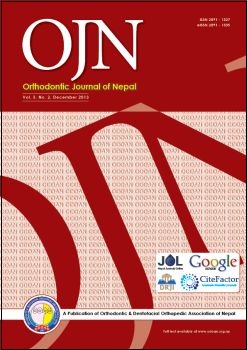Comparison of Maxillary and Mandibular Incisor Inclination in Class II Division 1 Malocclusion among Chinese Children
DOI:
https://doi.org/10.3126/ojn.v3i2.10074Keywords:
cephalometric radiographs, Class II Division 1 malocclusion, incisor inclinationAbstract
Objective: To determine maxillary and mandibular incisor inclination in Class II Division 1 malocclusion among different vertical skeletal type Chinese children.
Materials & Method: Lateral cephalograms of Class II Division I malocclusion cases of 120 Chinese children (male-55, female-65) of the age range 12-14 years were divided into three vertical skeletal types (low angle, average angle, high angle) based on Sella-Nasion to Mandibular plane angle. To determine incisor inclination, lateral cephalometric radiographs were measured and analyzed using factorial analysis. All angular parameters were processed using ANOVA and t-test. Maxillary and mandibular incisor inclinations were discussed in detail among three vertical facial skeletal types.
Result: The maxillary and mandibular incisors of low angle individuals were found to be proclined more than those with high and average angle individuals.
Conclusion: Different vertical facial types of Class II Division I malocclusion in early permanent dentition accord to establish discriminate values to set up the cephalometric standards for diagnosis and treatment planning for the clinicians.
Downloads
Downloads
Published
How to Cite
Issue
Section
License
Copyright © held by Orthodontic & Dentofacial Orthopedic Association of Nepal
- Copyright on any research article is transferred in full to the Orthodontic & Dentofacial Orthopedic Association of Nepal upon publication in the journal. The copyright transfer includes the right to reproduce and distribute the article in any form of reproduction (printing, electronic media or any other form).
- Articles in the Orthodontic Journal of Nepal are Open Access articles published under the Creative Commons CC BY License (https://creativecommons.org/licenses/by/4.0/)
- This license permits use, distribution and reproduction in any medium, provided the original work is properly cited.




